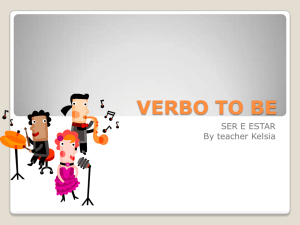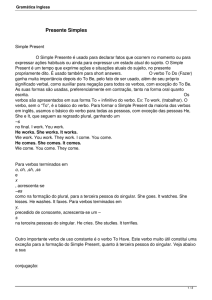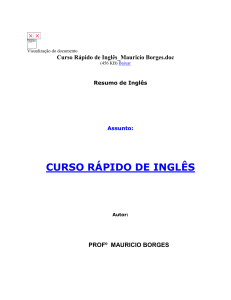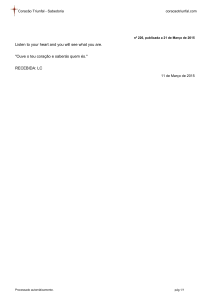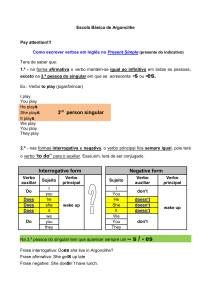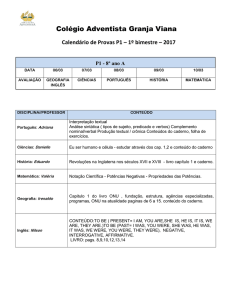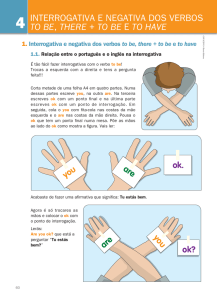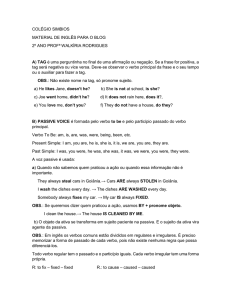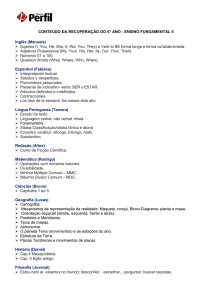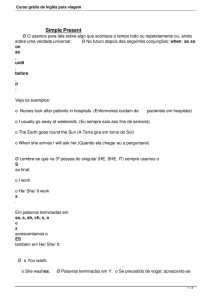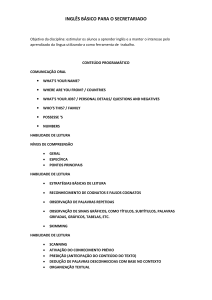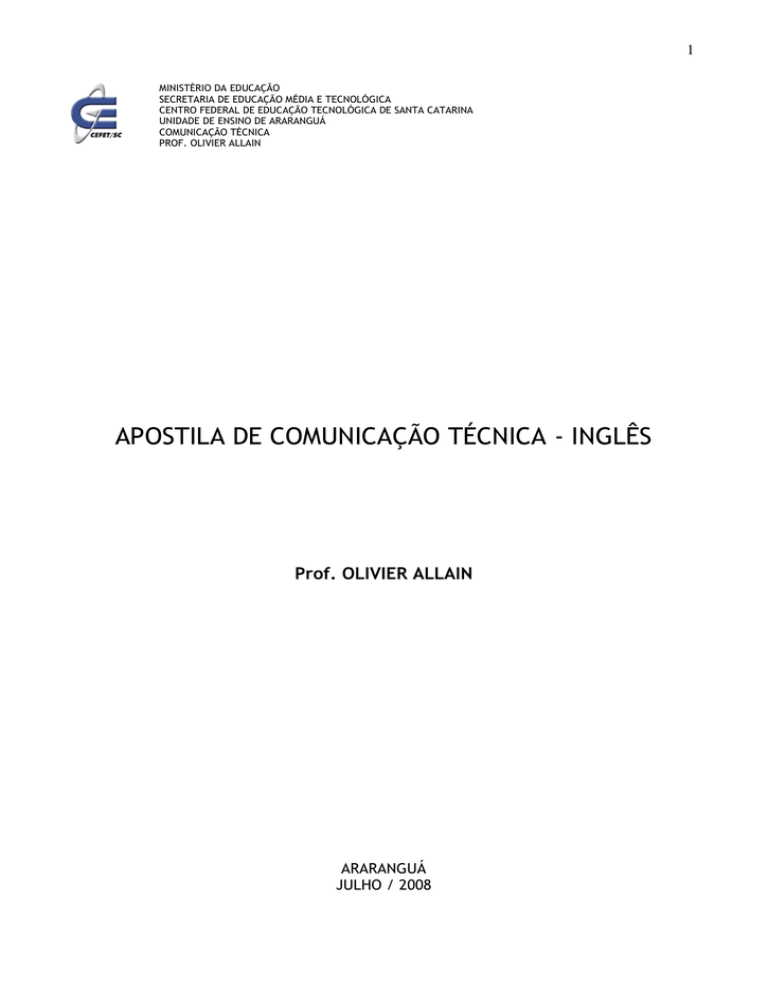
1
MINISTÉRIO DA EDUCAÇÃO
SECRETARIA DE EDUCAÇÃO MÉDIA E TECNOLÓGICA
CENTRO FEDERAL DE EDUCAÇÃO TECNOLÓGICA DE SANTA CATARINA
UNIDADE DE ENSINO DE ARARANGUÁ
COMUNICAÇÃO TÉCNICA
PROF. OLIVIER ALLAIN
APOSTILA DE COMUNICAÇÃO TÉCNICA - INGLÊS
Prof. OLIVIER ALLAIN
ARARANGUÁ
JULHO / 2008
2
PRIMEIRA PARTE - BASIC GRAMMAR
CARDINAL NUMBERS
Table of Cardinal Numbers
1 one 11 eleven
21 twenty-one
2 two
12 twelve
31 thirty-one
22 twenty-two
40 forty
3 three 13 thirteen
23 twenty-three
50 fifty
4 four 14 fourteen
24 twenty-four
60 sixty
5 five
15 fifteen
25 twenty-five
70 seventy
6 six
16 sixteen
26 twenty-six
80 eighty
7 seven 17 seventeen 27 twenty-seven
90 ninety
8 eight 18 eighteen 28 twenty-eight
100 a/one hundred
9 nine 19 nineteen 29 twenty-nine
1,000 a/one thousand
10 ten
20 twenty
30 thirty
1,000,000 a/one million
Separation between hundreds and tens (separação entre centenas e dezenas)
Hundreds and tens are usually separated by “and” (in American English 'and' is not necessary).
110 - one hundred and ten
1,250 - one thousand, two hundred and fifty
2,001 - two thousand and one
Hundreds
Use 100 always with “a” or “one”.
100 - a hundred / one hundred
'a' can only stand at the beginning of a number.
100 - a hundred / one hundred
2,100 - two thousand, one hundred
Thousands and Millions
Use 1,000 and 1,000,000 always with 'a' or 'one'.
3
1,000 - a thousand / one thousand
201,000 - two hundred and one thousand
Use commas as a separator.
57,458,302
Singular or Plural?
Numbers are usually written in singular.
two hundred Euros
several thousand light years
The plural is only used with dozen, hundred, thousand, million, billion, if they are not modified by
another number or expression (e.g. a few / several).
hundreds of Euros
thousands of light years
ORDINAL NUMBERS
Table of Ordinal Numbers
1 st
First
11 th eleventh
21 st twenty-first
31
st
thirty-first
2 nd Second
12 th twelfth
22 nd twenty-second 40
th
fortieth
3 rd third
13 th thirteenth
23 rd twenty-third
50
th
fiftieth
4 th fourth
14 th fourteenth
24 th twenty-fourth 60
th
sixtieth
5 th fifth
15 th fifteenth
25 th twenty-fifth
70
th
seventieth
6 th sixth
16 th sixteenth
26 th twenty-sixth
80
th
eightieth
7 th seventh
th
ninetieth
8 th eighth
17 th seventeenth 27 th twenty90
seventh
18 th eighteenth 28 th twenty-eighth 100
th
one hundredth
9 th ninth
19 th nineteenth 29 th twenty-ninth
1,000
th
one thousandth
10 th tenth
20 th twentieth
1,000,000
th
one millionth
30 th thirtieth
Form
Just add th to the cardinal number (Acrescente apenas th ao número cardinal):
- four - fourth
4
- eleven - eleventh
Exceptions:
one - first
two - second
three - third
five - fifth
eight - eighth
nine - ninth
twelve - twelfth
In compound ordinal numbers, note that only the last figure is written as an ordinal number:
421st = four hundred and twenty-first
5,111th = five thousand, one hundred and eleventh
Figures
When expressed as figures, the last two letters of the written word are added to the ordinal number:
first = 1st
second = 2nd
third = 3rd
fourth = 4th
twenty-sixth = 26th
hundred and first = 101st
Exercises
1. Write out these ordinal numbers:
a) 1st ______________ b) 2nd ______________ c) 3rd ______________ d) 5th _____________
e) 9th _______________ f) 12th _____________ g) 20th _____________
h) 21st ______________________ i) 43rd ____________________ j) 18th __________________
k) 39th ______________________ l) 77th ____________________ m) 60th _________________
n) 13th ___________________ o) 89th ______________________ p) 56th __________________
q) 92nd ___________________ r) 15th ______________________ s) 30th __________________
t) 100th __________________
2. Write out these dates:
a) 1972 ______________________________________________________________________
b) 1960 ______________________________________________________________________
5
c) 1856 ______________________________________________________________________
d) 1900 ______________________________________________________________________
e) 1607 ______________________________________________________________________
f) 1500 ______________________________________________________________________
g) 1779 ______________________________________________________________________
h) 1421 ______________________________________________________________________
i) 1908 ______________________________________________________________________
j) 2000 ______________________________________________________________________
ARTIGOS INDEFINIDOS
Os artigos indefinidos são usados para generalizar o substantivo. Em português temos os
seguintes artigos indefinidos: uma/umas um/uns. Em inglês “a/an” são os artigos indefinidos
singulares e “some” poderia ser uma boa tradução para os artigos indefinidos plurais. Estude os
exemplos abaixo:
Exemplos:
A car – Um carro (a /um – para mostrar que é um carro qualquer e não um carro específico
ou definido)
Some cars – Uns carros (some /uns– para mostrar que são quaisquer carros e não carros
específicos ou definidos)
A table – Uma mesa (a /uma – para mostrar que é uma mesa qualquer e não uma mesa
específica ou definida)
Some tables – Umas mesas (some /umas– para mostrar que são quaisquer mesas e não mesas
específicas ou definidas)
Quando usar a ou an?
Utiliza-se “a” quando o substantivo começa com uma consoante. Já o artigo indefinido “an” é
utilizado se este iniciar com uma vogal:
Exemplos:
An apple / uma maçã – apple é uma palavra iniciada por vogal por esta razão usamos o
artigo “an”
A table / uma mesa
6
An article / um artigo - article é uma palavra iniciada por vogal por esta razão usamos o
artigo “an”
A dog / um cachorro
Algumas exceções importantes
A university - mesmo que “university” comece com uma vogal utiliza-se o artigo indefinido
“a”.
An honor – mesmo que “honor” comece com uma consoante o som é de uma vogal e por
esta razão se deve usar o artigo “an”.
OS ARTIGOS DEFINIDOS
Os artigos definidos são usados para especificar o substantivo. Em português temos os
seguintes artigos: a/as o/os. Em inglês tais artigos podem ser traduzidos para uma única palavra
“the”. Observe os exemplos abaixo:
The car – O carro (the /o – para mostrar que é um carro específico, definido e não um carro
qualquer)
The cars – Os carros (the /os – para mostrar que são carros específicos e definidos)
The table – A mesa (the /a – para mostrar que é uma mesa específica, definida e não uma
mesa qualquer)
The tables – As mesas (the /as – para mostrar que são mesas específicas e definidas)
Agora estude o quadro abaixo para fixar e memorizar os artigos em inglês:
Articles
Definido
a/as o/os
Indefinido
Uma/ uma um/uns
Singular
The
A / Na
Plural
The
Some
Após estudar esse quadro você pode perceber que em inglês as palavras não possuem gênero
feminino ou masculino, diferente do que ocorre em português.
Exercise:
Write a or na:
1) ____ airplaine; 2) ____ exercise; 3) ____ envelope; 4) ____ girl; 5) ____ student; 6) ____ article;
7) ____ elephant; 8) ____ banana; 9) ____ rose; 10) ____ egg.
7
Verb TO BE
FORMA
TRADUÇÃO
FORMA
AFIRMATIVA
CONTRAÍDA
I am
Eu sou/estou
I’m
You are
Você é/está tu és/estás
You’re
He is
Ele é/está
He’s
She is
Ela é /está
She’s
It is
Ele(a)é/está
It’s
We are
Nós somos/estamos
We’re
You are
Vós sois/estais
You’re
They are
Eles são/estão
They’re
FORMA
TRADUÇÃO
FORMA
NEGATIVA
CONTRAÍDA
I am not
Eu não sou/não estou
I’m not / I ain’t
You are not
Você não é/não está
You aren’t
He is not
Ele não é /não está
He isn’t
She is not
Ela não é/não está
She isn’t
It is not
Ele(a) não é/não está
It isn’t
We are not
Nós não somos/não estamos
We aren’t
You are not
Vocês não são/não estão
You aren’t
They are not
Eles não são/não estão
They aren’t
FORMA INTERROGATIVA
Am I ?
Are you ?
Is he ?
Is she ?
Is it ?
Are we ?
Are you ?
Are they ?
SIGNIFICADO
8
Exercice
Substitua as palavras sublinhadas pela alternativa correta:
1) Paul and I are friends
a)
b)
c)
d)
you
we
they
he
2) Mary is a nice person.
a)
b)
c)
d)
she
he
we
they
3) John, Lisa and Maggie are my cousins.
a)
b)
c)
d)
I
we
it
they
4) Henry works in Chicago.
a)
b)
c)
d)
it
we
he
you
Exercise – VERB TO BE
1) Complete as sentenças :
a) You __________ a good dressmaker.
b) He __________ a famous supervisor.
c) Is __________ a hem.
d) We __________ friends.
e) She __________ my boss.
f) You __________ smart students.
g) They __________ assistant.
9
2) Use a forma negativa :
a) They are happy girls. ____________________________________________________
b) She is a good secretary. __________________________________________________
c) We are your friends. _____________________________________________________
d) He is near the school. ____________________________________________________
e) You are lazy people. _____________________________________________________
f) It is a collar. ____________________________________________________________
3) Use a forma interrogativa :
a) She is the teacher. _______________________________________________________
b) He is your father. ________________________________________________________
c) She is your sister. ________________________________________________________
d) You are my friend. _______________________________________________________
e) They are good boys. ______________________________________________________
f) It is a sleeve. ____________________________________________________________
3) Faça duas frases usando as formas : afirmativa, negativa e interrogativa.
a) Afirmativa:
b) Interrogativa:
c) Negativa:
Vocabulary: SHAPES (Formas)
Compare essas formas:
1)
2)
10
3)
4)
5)
6)
Activity:
1) Coloque os números de acordo com as formas:
a) (
) It’s thick.
b) (
) It’s short.
c) (
) It’s square.
d) (
) It’s long.
e) (
) It’s round.
f) (
) It’s thin.
Activity: Leia e tente adivinhar:
a) It’s long and thin. You write with it: __________________________
b) It’s brown and square with four legs: __________________________
c) It’s round and white: __________________________
d) It’s soft and square. It’s on your bed: __________________________
e) It’s long and sharp. You cut with it: __________________________
f) It’s thick and square. You read it: __________________________
11
Verb TO HAVE
I
HAVE
Eu tenho
YOU
HAVE
Tu/Você tem
HE
HAS
Ele tem
SHE
HAS
Ela tem
IT
HAS
Ele ou ela (neutro) tem
WE
HAVE
Nós temos
YOU
HAVE
Vocês têm
THEY
HAVE
Eles têm
I
DON’T have
a brother
YOU
DON’T have
money
HE
DOESN’T have
a sister
SHE
DOESN’T have
a book
IT
DOESN’T have
water
WE
DON’T have
a pencil
YOU
DON’T have
a car
THEY
DON’T have
a radio
Do
I
have…?
Do
you
have…?
Does
he
has…?
Does
she
has…?
Does
it
has…?
Do
we
have…?
Do
you
have…?
Do
they
have…?
FORMA NEGATIVA
FORMA INTERROGATIVA
Exercises
1) Complete as orações com has ou have:
12
a) We _________ two arms.
b) She _________ to take care of it.
c) The human body _________ very important parts.
d) A hand _________ two fingers.
2) Passe as frases abaixo para a forma negativa e interrogativa:
a) Susan has beautiful eyes.
N ____________________________________________________________________________
I ____________________________________________________________________________
b) Tom and Peter have a car.
N ____________________________________________________________________________
I ____________________________________________________________________________
PLURAL OF NOUNS
1. Em geral, forma-se o plural dos substantivos, em inglês, acrescentando-se S ao singular: car –
cars; book – books; bird – birds; etc.
Exercise
1) Escreva no plural:
a) Boy ____________________
b) Pen ____________________
c) Tree ____________________
d) dog ____________________
e) house ____________________
f) table ____________________
g) cat ____________________
h) apple ____________________
i) book ____________________
2) Escreva as frases no plural (observe que o artigo the e o adjetivo não mudam)
a) The boy is good. The boys are good.
b) The appel is red. ________________________________________
c) The house is white. ________________________________________
d) The magazine is new. ________________________________________
13
e) She is beautiful. ________________________________________
f) This is a book. ________________________________________
g) This is a flower. ________________________________________
h) That is a yellow bird. ________________________________________
i) That is a plane. ________________________________________
2. Os substantives terminados em CH, S, SH, SS, X, Z formam o plural adicionando ES:
Glass → glasses (copos)
Brush → brushes (escovas)
Church → churches (igrejas)
Box → boxes (caixas)
Adress → adresses (endereços)
3. Substantivos terminados em O, adiciona-se ES:
Mango → mangoes (_______________)
Hero → heroes (_______________)
Potato → potatoes (_______________)
4. Os substantivos terminados em Y precedidos de consoantes, formam o plural mudando o Y para
IES:
Story → stories (_______________)
Fly → flies (moscas)
City → cities (_______________)
Lady → ladies (_______________)
5. Seguem a regra geral, os substantivos terminados em Y precedidos de vogal:
Day → days (_______________)
Boy → boys (_______________)
Key → keys (_______________)
Valley → valleys (_______________)
6. Os substantivos terminados em F e FE, formam o plural trocando o F ou FE por VES:
Leaf → leaves (folhas)
Knife → knives (facas)
Life → lives (_______________)
14
Wife → wives (_______________)
7. Os substantivos abaixo formam o plural irregular:
Man → men (_______________)
Woman → women (_______________)
Foot → feet (_______________)
Die → dice (dados)
Tooth → teeth (dentes)
8. Alguns substantivos não tem singular, somente plural:
Scissors (tesoura)
Pants (calça)
9. Alguns se usam no singular:
Bread (pão)
Business (_______________)
Knowledge (conhecimento)
Vocabulary
Bottle – _______________
Beer – _______________
Under – _______________
Chair – _______________
Old – _______________
Drugstore – _______________
Near – _______________
Far – _______________
Face – ________________
Who – _______________
Mango – _______________
Peach – _______________
Exercise
Check the correct alternative:
15
1) There is – _______________ empty bottle of beer under – _______________ chair.
a) the – an
b) an – the
c) a – an
d) a – a
2) – _______________ miss Kent is working in – _______________ hotel near –
_______________ old drugstore.
a) a – the – a
b) the – an – the
c) X – a – an
d) The – X – a
3) She’s – _______________ old woman but she has – _______________ nice face.
a) an – a
b) the – an
c) a – a
d) an – an
4) Who is – _______________ new president of – _______________ U.S. A.
a) a – a
b) the – the
c) the – an
d) an – the
Check the correct alternative again:
1) O plural de fly é:
a) flys
b) flies
c) flyies
d) flis
2) Lives é o plural da palavra:
a) leaf
16
b) live
c) life
d) love
3) Passe para o plural
a) mango – _______________
b) peach – _______________
c) foot – _______________
d) secretary – _______________
e) box – _______________
f) city – _______________
g) potato – _______________
h) knife – _______________
i) woman – _______________
17
SIMPLE PRESENT – Presente simples: indica uma ação que se faz costumeiramente, que se
repete normalmente.
Observe as frases abaixo:
- Everybody calls me Mel.
- I live in a quiet city.
As palavras destacadas são verbos conjugados no presente simples. Vamos estudar sua estrutura:
Verb To call – chamar
Verb To live – viver, morar
I call
I live
You call
You live
He/She/it calls
He/She/it lives
We call
We live
You call
You live
They call
They live
Para conjugar os verbos, no presente simples, retiramos a partícula to (verbo no infinitivo)
Ex: To call – chamar
I call – Eu chamo
Os verbos, na 3ª pessoa do singular (he, she, it) recebem um s.
Ex: He calls (ele chama).
Os verbos terminados em s, sh, ch, o, x, recebem es na 3ª pessoa.
Ex: She watches (ela assiste); She goes (ela vai).
Os verbos terminados em y precedidos por vogal recebem apenas s. Ex: He plays.
Os verbos terminados em y precedidos de consoante mudam o y por ies. Ex: It fly – It flies
(ele voa).
Forma Negativa: usamos os auxiliares don’t e doesn’t.
Ex: I, you, we, they don’t have a car.
She, he, it doesn’t have food.
Forma Interrogativa: usamos os auxiliares Do e Does.
Ex: Do (you, we, I, they) like chocolate?
Does (she, he, it) want water?
1) Mude as frases para a forma negativa ou afirmativa.
Exemplos:
18
I like cheese.
I don't like cheese.
I don't like garlic.
I like garlic.
a) Our lessons start at eleven o'clock.
Our lessons _________ at eleven o'clock.
b) He doesn't work in a bookshop.
He _________ in a bookshop.
c) We live in a small town.
We _________ in a small town.
d) Her mother speaks English fluently.
Her mother _________ English fluently.
e) Mrs Smith doesn't know the man's name.
Mrs Smith _________ the man's name.
f) He comes from Chester, England.
He _________ from Chester, England
2) Mude as frases para a forma interrogativa.
Exemplos:
You like ice cream.
Do you like ice cream?
They play rugby.
Do they play rugby?
a) You play tennis.
_________________ tennis?
19
b) They have a house.
_________________ a house?
c) The phone rings every day.
_________________ every day?
d) He knows his teacher.
_________________ his teacher?
e) You enjoy reading.
_________________ reading?
f) He believes in ghosts.
_________________ in ghosts?
g) She sells paintings.
_________________ paintings?
3) Complete as frases com os verbos no Present Simple.
Exemplos:
I like (like) ice cream, but Susan doesn't.
Do you have (you, have) any cats? No, I don't like (not like) them.
a) John __________ (like) Wendy, but she __________ (not like) him very much.
b) Where ____________________ (your sister, work)? She __________ (work) in a café.
c) ____________________ (you, like) garlic? No, I __________.
d) What ____________________ (your wife, do)? She's a judge.
e) My father ___________ (work) in an office and he __________ (go) to work by train.
f) What newspaper _________________ (you, read)? I __________ (read) the Times.
g) Where ____________________ (he, live)? He __________ (live) opposite the museum.
h) Everybody in my class __________ (speak) French.
20
i) What language besides Russian ____________________ (they, speak)?
“WH” QUESTIONS (Interrogative pronouns)
1 – WHO: QUEM
Who is that man? (Quem é aquele homem?)
Who are those people? (Quem são aquelas pessoas?)
Who wants to eat pizza? (Quem quer comer pizza?)
2 – WHAT – O QUE, QUAL (empregado também para perguntar sobre profissão ou cargo)
What is she? She is a secretary. (O que ela é? Ela é uma secretária)
What’s your name? (______________________)
What is this? (O que é isso?)
3 – WHERE - ONDE
Where is the book? (_______________________)
Where are you? (_______________________)
4. HOW – COMO
How are you? (_______________________)
How is your father? (_______________________)
How can I say “batata”? (Como posso dizer batata?)
5 – HOW OLD are you? I’m twenty. (Que idade você tem? Tenho vinte)
How old is she? (Que idade ela tem?)
6 – HOW MANY: QUANTOS, QUANTAS (usado antes de quantidade enumerada)
How many shirts can you see? (Quantas camisas você pode ver?)
7. HOW MUCH: QUANTO
How much is it? (Quanto é?)
How much does it cost? (_______________________)
8 – WHY – POR QUE?
Why is she happy? (Por que ela está tão feliz?)
21
OBS.: NA RESPOSTA, USA-SE BECAUSE:
She is happy because she won the lottery. (__________________________________________)
Exercises
1) Formule as perguntas de acordo com as respostas:
a) __________________________________________________________________________
My name is John.
b) __________________________________________________________________________
I am a supervisor.
c) __________________________________________________________________________
I am forty-five years old.
d) __________________________________________________________________________
My boss is here.
e) __________________________________________________________________________
I have ten dogs.
f) __________________________________________________________________________
Because I am hungry.
2) Escreva em inglês:
a) Ela é uma costureira. ________________________________________________________
b) Eu tenho vinte anos _________________________________________________________
c) Quem são aquelas damas? ____________________________________________________
d) Quanto é uma tradução? ______________________________________________________
e) O que é isso? _______________________________________________________________
f) Quantos primos você tem? ____________________________________________________
g) Por que ele está feliz? ________________________________________________________
22
PREPOSIÇÕES BÁSICAS
IN – ON – AT
Observe o emprego das preposições in, on e at, com relação a tempo e lugar:
Tempo
Mario was born
in 1970.
(ano)
in December.
(mês)
on a Sunday.
(dia da semana)
on the 27th of December 1970. (data)
at 7 o’clock.
(hora)
Lugar
Mario lives
in Brazil
(país)
in São Paulo
(cidade)
on Brazil avenue
(rua)
at 27 Siriema Street (n° de rua)
Observações
1. Para grandes unidades (ano, mês, país, cidade), emprega-se a preposição in.
2. Para as unidades médias (dia da semana, datas, ruas), usa-se a preposição on.
3. Para as unidades pequenas (horas e n° de rua) usamos at.
4. Leitura de datas. Exemplo. 27 December 1970 (the twenty-seventh of December nineteen
seventy).
Exercise
Answer the questions. Look at the model:
a) What time do you get up? (7 o’clock)
I get up at 7 o’clock
b) What time do you go to work?
_________________________________________________________________________
c) Where were you born? (Brazil)
I was born ________________________________________________________________
d) Where were you born? (cidade)
23
_________________________________________________________________________
e) When were you born? (ano)
_________________________________________________________________________
f) When were you born? (dia/mês/ano) (data)
_________________________________________________________________________
h) Where do you live? (país)
_________________________________________________________________________
i) Where do you live? (país)
_________________________________________________________________________
j) What is your address?
_________________________________________________________________________
OUTRAS PREPOSIÇÕES BÁSICAS
IN – idéia de interioridade
Ex.: The book in my bag. (_________________________________________)
ON – idéia de “na superfície”
Ex.: The book is on the table. (_________________________________________)
AT – idéia de localização num determinado ponto
Ex.: He is at the window. (_________________________________________)
IN FRONT OF – em frente a, na frente de
Ex.: He is in front of your house. (_________________________________________)
UNDER – em baixo de, abaixo de
Ex.: The book is under your chair. (_________________________________________)
BEHIND – atrás de
Ex.: The bicycle is behind the wall. (_________________________________________)
BETWEEN – entre
Ex.: The bicycle is between the car and the wall. (_______________________________________)
24
INSIDE – dentro de
Ex.: Come inside the house! (_________________________________________)
OUTSIDE – fora de
Ex.: The bicycle is outside the house. (_________________________________________)
BESIDE – ao lado de
Ex.: Can I sit beside you? (_________________________________________)
NEXT TO – perto de
Ex.: Can I sit next to you? (_________________________________________)
Exercise
Complete the sentences with the following prepositions: in, on, under, behind, beside, next to,
between, inside, outside, in front of
25
OBSERVAÇÃO: Há uma lista de preposições suplementares no final da apostila.
26
IMPERATIVE
Observe o seguinte texto:
“Eat sensibly.
Do not eat sweets, pastry, pasta or fried food.
Do some kind of aerobic activity…
Don’t be lazy!
Do everything that I say and…”
Nessas frases, podemos observar algumas instruções e até mesmo ordens. Para fazer todas
estas coisas, os verbos das frases foram colocadas em uma forma diferente: o modo imperativo.
Uso: O modo imperativo é usado para dar conselhos, instruções e ordens. Ele também pode ser
usado para:
→ Dar sugestões:
Ex.: Try this coat on. It is very nice and cheap.
→ Encorajar alguém:
Ex.: Go, Lakers, go! (em uma torcida).
→ Fazer um pedido:
Ex.: Call a taxi for me, please.
Forma: Os verbos no modo imperativo ficam sempre no início da oração, e a frase não tem sujeito
(o sujeito é quem está recebendo a ordem, a sugestão, o conselho, etc.).
Nas frases afirmativas, o verbo não sofre alteração, ficando no infinitivo (sem o “to”).
Na forma negativa, sempre acrescentamos o don’t em frente a esse infinitivo. Perceba que, apesar
de nunca usarmos o auxiliar “DO” com o verbo to be, neste caso, isto deverá ocorrer.
Ex: Don’t be a foll!
Always, Never: Quando aparecem em frases imperativas, estes dois advérbios sempre serão
colocados antes do verbo. Eles servem para enfatizar a ordem.
Ex: Always obey your fatlher and your mother.
Never stay under a tree during a thunderstorm.
Exercise
27
1) Make these sentences negative. (____________________________________)
Ex.: Go to the theater.
Don't go to the theater!
a) Buy a motorcycle ______________________________________________
b) Sell your house ______________________________________________
c) Give me another drink ______________________________________________
d) Lend her some money ______________________________________________
2. Make these sentences imperative. (_____________________________________)
Ex.: They don't do the homework.
Do the homework!
a) I can't write in Japanese ______________________________________________
b) She isn't going to make a good sandwich _____________________________________________
c) I don't like to write in ink ______________________________________________
d) He isn't calm ______________________________________________
3. Escreva em ingles:
a) Use essa bobina _____________________________________________________
b) Não coloque esse parafuso aqui ________________________________________________
c) Por favor, conecte a máquina __________________________________________________
d) Proteja-se do choque elétrico __________________________________________________
e) Siga as intruções _____________________________________________________
f) Abra o motor _____________________________________________________
g) Feche a trena _____________________________________________________
h) Gire o eixo _____________________________________________________
i) Ligue a luz _____________________________________________________
28
29
ADJECTIVES (Comparativos e superlativos)
Na língua inglesa, a maioria dos adjetivos é colocada antes dos substantivos (Ex: New York
is a large city. = Nova York é uma grande cidade.) ou depois de um verbo de ligação (Ex: He is
very smart. = Ele é muito esperto). Se na língua inglesa colocamos o adjetivo antes do substantivo
(New York is a large city), no português é exatamente o contrário, normalmente o substantivo vem
antes do adjetivo (Nova York é uma cidade grande). É importante perceber que essa é uma das
maiores diferenças entre o inglês e o português.
Os adjetivos podem variar segundo a intensidade:
Lovely (+ +), very good (+) ← OK → very bad (-), awful(- -)
Os adjetivos no centro são chamados de adjetivos de “escala” e dão a descrição geral de
alguma coisa. Você pode usar “very” (+ e -) antes deles para intensificar um pouco o adjetivo. Os
adjetivos do lado esquerdo e direito (+ + e - -) são chamados de adjetivos de “limite” e transmitem
uma descrição extrema de algo.
Para comparar as coisas, pessoas, conceitos e etc., existem formas de comparação dos
adjetivos, podendo ser de superioridade, igualdade e inferioridade.
Comparativo de superioridade
- Nos casos de adjetivos com uma sílaba, usa-se (adjetivo + -er than). Ex: Karla is very smart. She
is smarter than July. = Karla é muito esperta. Ela é mais esperta do que July.
- Quando os adjetivos possuem uma ou duas sílabas terminadas em consoante + y, se usa a fórmula
(adjetivo + -ier than). Ex: Sonia was silly. She was sillier than Mary. = Sonia era tola. Ela era mais
tola que Mary.
- Nos casos de adjetivos com duas sílabas ou mais, usa-se (more + adjetivo + than). Ex: He is
more famous than Jone. = Ele é mais famoso do que Jone.
Comparativo de igualdade
Para compararmos as condições igualitárias de duas coisas, usamos a expressão: (as + adjetivo +
as).
Ex:
He
is
as
nice
Comparativo de inferioridade
as
Brian.
=
Ele
é
tão
agradável
quanto
Brian.
30
Quando queremos comparar e demonstrar a condição inferior de uma coisa em relação à outra,
usamos: (less + adjetivo + than). Ex: Joseph is less shy than Jone. = Joseph é menos tímido do que
Jone.
Superlativos
Na ocasião de querermos classificar algo não no âmbito comparativo, mas sim, no âmbito geral, ou
seja, quando queremos atribuir máxima intensificação do adjetivo a algo, usamos a forma
superlativa. Um adjetivo na forma superlativa indica que algo tem uma característica em um grau
maior do que qualquer outra coisa com que se possa comparar em um contexto. O superlativo
refere-se
ao
maior,
menor,
pior,
melhor,
etc.
Para se construir uma expressão com o adjetivo na forma superlativa, usamos:
- (the + adjetivo + est), quando o adjetivo tiver uma sílaba ou duas sílabas terminadas em “le”; “y”;
“ow”; “er”;
- (the most +adjetivo), nos demais casos.
Ex: I am the oldest. = Eu sou o mais velho.
She is the youngest. = Ela é a mais jovem.
Exercise
1) Complete as frases com os comparativos e os superlativos dos adjectivos entre parênteses:
a) She is _____________ person I know. (happy)
b) The Amazonian forest is __________________ in the world. (large)
c) Her car is ___________________ mine. (economical)
d) This exercise is _________________ that one. (easy)
e) Her house is __________________ yours. (big)
f) This computer is __________________of the three. (expensive)
g) She swims ____________________ I do. (good)
h) That is __________________ film I've ever seen. (bad)
i) Oporto is _________________ Coimbra. (far)
j) This snake is _________________ of all we have here. (dangerous)
31
DEMONSTRATIVE PRONOUNS
Demonstrative Pronouns servem para apontar, indicar e mostrar alguma coisa, lugar, pessoa
ou objeto. Os demonstrative pronouns podem estar no singular (this = isto ou that = aquilo) e no
plural (these = estes ou those = aqueles).
Singular: This (isto, este, esta), that (aquilo, aquele, aquela).
- This refere-se a algo próximo de quem fala.
- That refere-se a algo distante de quem fala.
- This e that; podem funcionar como adjetivos, antes do substantivo (this sandwich; that salad), ou
como pronomes substantivos (this is for you; that is for me).
Exemplo: What’s this? – pergunta o que é uma coisa que está perto da pessoa que fala.
What’s that? – pergunta o que é uma coisa que está longe da pessoa que fala.
Plural: these (estes; estas), those (aqueles; aquelas).
- These refere-se a tudo que está próximo de quem fala.
- Those refere-se a tudo que está distante de quem fala.
- These e those; podem funcionar como adjetivos, antes do substantivo (these cookies; those pies),
ou como pronomes substantivos (these are good; those are bad).
Exemplo: What are these? - pergunta "o que são estas" coisas que estão perto da pessoa que fala.
What are those? – pergunta "o que são aquelas" coisas que estão longe da pessoa que
fala.
Exercises
1. Choose the correct alternative (_____________________________________):
a) (That, Those) are the shoes I want.
b) I'm tired of (this, these) job.
c) Mother, (this, those) is my friend Cindy and (that, those) are her brothers.
d) Let's play with (that, those) children.
e) My father is (this, that) man talking to (that, those) women near the bank.
f) (This, These) chair is very comfortable but (that, those) table is too small.
g) What are you going to say about (this, these) problem?
2. Supply this, that, these or those in the gaps (________________________________________):
32
a) Look! _________________ is my girlfriend inside the restaurant.
b) Let's help _________________ little boys near that tree.
c) _________________ isn't my book. My book is over there on the table.
d) Oh, _________________ pictures are beautiful,Tom. Bring them here, please.
e) What are _________________ black spots on my fingers, doctor?
f) _________________ is my new English teacher across the street.
g) Guess, what is _________________in my hands?
h) Mom, _________________ are my new friends from school.
i) What is _________________ on the top of the building?
33
THERE TO BE (Haver, existir…)
1. Singular:
There is an egg in the box. (Há, existe, tem um ovo na caixa)
There is a bird in the nest. (Há um pássaro no ninho)
2. Plural:
There are eggs in the box. (Há, existem, tem ovos na caixa)
There are birds in the nest. (Há, existem pássaros no ninho)
3. Forma negativa: Basta acrescentar a partícula not log após o verbo.
There is not an egg in the box.
4. Forma interrogativa: Basta inverter sujeito e verbo (Is there...? Are there...?)
Is there na egg in the box?
Are there birds in the nest?
34
Exercise: Describe what you see on this picture (and imagine what other activities there are for:
THERE IS / THERE ARE / IT IS / THEY ARE
35
36
Activity
Say what these people are doing on the following pictures:
Madonna…______________________________________________________________________
________________________________________________________________________________
________________________________________________________________________________
________________________________________________________________________________
________________________________________________________________________________
________________________________________________________________________________
________________________________________________________________________________
37
Vocabulary: FEELINGS (__________)
38
VERB TO BE – Past tense
AFIRMATIVA
NEGATIVA
ABREVIAÇÃO
INTERROGATIVA
I was
I was not
I wasn’t
Was I?
You were
You were not
You weren’t
Were you?
He / She / It was
He / She / It was not
He / She / It wasn’t
Was he/ she / it ?
We were
We were not
We weren’t
Were we?
You were
You were not
You weren’t
Were you?
They were
They were not
They weren’t
Were they?
Text: A trip.
Jack: Hi, John!
John: Hi, Jack!
Jack: Welcome back! How was your trip?
John: Oh, it was fantastic. I had a wonderful time. And people in California are very nice.
Jack: Your wife was happy to travel?
John: Yes, she was delighted!
Activity
1) Identifique e escreva abaixo quais as palavras que indicam tempo passado no texto.
2) Mude os verbos em negrito para o tempo passado.
a) I am very tired. I was very tired.
b) They are in Italy. ______________________________________________
c) You are sick ______________________________________________
d) She is very nice. ______________________________________________
e) It is there. ______________________________________________
f) I was late. ______________________________________________
3) Complete com was ou were e diga o que as pessoas se tornaram:
a) I ___________ a teacher. Now I am a dentist.
39
b) Peter ___________ a student. Now _________________________________
c) They ___________ dressmakers. _________________________________
d) She ___________ my friend. _________________________________
e) We ___________ at school yesterday. _________________________________
f) He ___________ here two minutes ago. _________________________________
g) You ___________ with your friends last week. _________________________________
4) Reescreva as frases a, c, e, g, passando-as para as formas: negativa e interrogativa:
a) Neg. __________________________________________________________________
Int. __________________________________________________________________
c) Neg. __________________________________________________________________
Int. __________________________________________________________________
e) Neg. __________________________________________________________________
Int. __________________________________________________________________
g) Neg. __________________________________________________________________
Int. __________________________________________________________________
40
GOING TO – O FUTURO INFORMAL
Be going to é uma estrutura que pode ser usada para falarmos de planos futuros de forma
informal. Going to enfatiza a idéia de intenção, de uma decisão que já foi tomada.
Ex.: Mark is going to cross Ireland.
His friends are going to help him.
Um outro uso do going to é o de predizer o futuro devido a um indício presente.
Ex.: Look at the sky! It's going to rain.
They drive dangerously. They are going to crash.
Forma
Esta forma de futuro é um tempo verbal composto, formado pelo verbo to be no presente simples
(am, is, are) e going to, ao que adicionamos a forma natural do verbo que desejamos colocar no
futuro.
Ex.: I am going to travel to Europe next year.
I am going to write a novel.
41
42
SIMPLE PAST
Significado
O simple past é usado quando nos referimos a eventos que ocorreram em um tempo detrminado no
passado.
Sendo assim, podemos concluir que o Simple Past é usado:
- Para ações que se completaram no passado em tempo definido estabelecido na frase.
Ex: He died in 1908. (Ele morreu em 1908).
- Em contextos que nos reportem ao passado, mesmo desprovido de indicação temporal.
Ex: I’m sorry about last night. The train was 10 minutes late. (Desculpe-me sobre a noite passada. O
trem estava 10 minutos atrasado).
Forma
O Simple Past é um tempo verbal simples, formado apenas por um verbo principal flexionado na
forma do passado, e que faz uso do verbo auxiliar apenas nas formas interrogativas e negativas.
A flexão do verbo no passado será feita diferentemente para verbos regulares e irregulares.
1. Os verbos regulares recebem a terminação –ed para formar o passado.
Ex: Clean – cleaned
Wash – washed
Y – Verbos terminados em y, sendo esta letra precedida de uma consoante, perderão o y para, então,
ser acrescentada a terminação – ied. Caso a letra y seja precedida de uma vogal, não há mudanças.
Ex: study – studied Mas play – Played
Try – tried Mas destroy – Destroyed
Exercise
Complete as frases passando os verbos entre parênteses para o Simple past (passado):
a) John usually goes to school by bus, but yesterday he ___________
(walk) because it
___________ (be) a beautiful day.
b) When Mary and Jake ___________ (arrive) at the party, they ___________ (look) for Mike but
couldn't find him.
43
c) We ___________ (watch) Star Wars last week. I ___________ (like) it a lot, but my friends
didn't.
d) Tony and Tim ___________ (play) basketball as children. Tim also ___________ (study)
French and piano.
2. Os verbos irregulares no passado têm a mesma forma para todas as pessoas:
Ex: To go – went
(ir)
to find - found
(fui, fostes, foi, fomos...)
(encontrar) (encontrei, encontrou, encontraram...)
Exercises
1) Escreva ( R ) para os verbos regulares e ( I ) para os verbos irregulares:
a) to live – lived
(
)
b) to see – saw
(
)
c) to love – loved
(
)
d) to fly - flew
(
)
e) to have – had
(
)
f) to use – used
(
)
g) to go – went
(
)
h) to come – came
(
)
i) to be – was, were
(
)
j) to dance – danced (
)
k) to eat – ate
(
)
l) to drink – drank
(
)
m) to pull – pulled
(
)
2) Complete as frases usando os verbos no passado:
a) I try to understand you. ____________________________________________________
b) The men carry the bags. ____________________________________________________
c) The baby cries because he is hungry. __________________________________________
d) The children like chocolate. _________________________________________________
e) People believe in God. ______________________________________________________
44
f) I study here. ______________________________________________________________
g) She wants to see the film. ____________________________________________________
h) I drink milk. ______________________________________________________________
VERBOS IRREGULARES MAIS USADOS (Há uma lista completa dos verbos irregulares
para consulta no final da apostila)
Infinitivo
Simple past
Tradução
to buy
bought
comprar
to make
made
fazer
to go
went
ir
to see
saw
ver
to lose
lost
perder
to steal
stole
roubar
to catch
caught
pegar
to give
gave
dar
to sell
sold
vender
to fall
fell
cair
to feel
felt
sentir
to send
sent
enviar
to read
read
ler
to write
wrote
escrever
to cost
cost
custar
to cut
cut
cortar
to have
had
ter
to begin
began
começar
to know
knew
conhecer, saber
to bring
brought
trazer
Exercises
1) Complete as frases colocando os verbos entre parênteses no Simple past (passado)
a) Yesterday my friend Sally and I ___________ (go) to the supermarket to buy food. We
___________ (find) everything we___________ (want), except my favorite cookies.
45
b) My TV ___________ (be) broken last week, so I ___________ (read) all my magazines in my
free time.
c) Janet ___________ (make) three delicious dishes for lunch last Saturday. We ___________
(eat) all the food - there was nothing left.
d) I ___________ (lose) my wallet yesterday, but thankfully a girl from my school ___________
(find) it and ___________ (give) me a call.
e) Where Monica and Sandra ___________ (be) children, they ___________ (have) three dogs
and a bird. They ___________ (live) in a farm, so the dogs ___________ (have) a lot of space to
play.
DID – A FORMA NEGATIVA E A FORMA INTERROGATIVA
Os tempos verbais simples necessitam de um verbo auxiliar para formarem frases interrogativas e
negativas. O Simple Past usará o verbo auxiliar did para todas as pessoas, indistintamente. Da
mesma forma que o Simple Present na terceira pessoa do singular requer que o “s” seja retirado do
verbo que já está flexionado para poder passa-lo para as formas negativa e interrogativa, o auxiliar
did exige que o verbo seja colocado novamente em sua forma natural (básica), pois a presença do
did ao lado de um verbo por si só indica que ele está no passado simples.
Frases Negativas
Observe as seguintes frases:
Mark liked clean things. He didn’t like dirty places. (Mark gostava de coisas limpas. Ele não
gostava de lugares sujos.)
He helped his mother and he didn’t study. (Ele ajudava a sua mãe e ele não estudava).
* As primeiras frases são afirmativas, portanto o verbo está flexionado. Ao formamos uma frase
negativa, dispensa-se a flexão e acrescenta-se did not ou a sua forma contra didn’t.
Frases Interrogativas
Para a construção das frases interrogativas, coloca-se o verbo auxiliar did antes do sujeito da frase e
recoloca-se o verbo em sua forma básica.
Ex: Did his mother help him? (A mãe dele o ajudava?).
Yes, his mother helped him. (Sim, a mãe dele o ajudava).
46
Exercises
1) Escreva as frases na forma interrogativa:
a) The boys played football yesterday.
Did the boys play football yesterday?
b) They worked in a big factory.
____________ they ____________ in a big factory?
c) The girls studied their lesson.
____________ the girls ____________ their lesson?
2) Complete as frases colocando os verbos entre parênteses no Simple past (passado)
47
Activity – WHAT HAPPENED IN THIS MESSY ROOM?
Say what the boy did last night to mess his bedroom like this:
________________________________________________________________________________
________________________________________________________________________________
________________________________________________________________________________
________________________________________________________________________________
________________________________________________________________________________
________________________________________________________________________________
________________________________________________________________________________
________________________________________________________________________________
________________________________________________________________________________
________________________________________________________________________________
48
MODAL VERB – CAN / COULD
CAN – significa “poder”, no sentido de capacidade física ou mental, entre outros significados. Não
recebe S na 3ª pessoa do singular.
Present Tense
I
I
You
You
He
She
It
We
You
They
Past Tense
He
CAN
She
It
We
You
They
COULD
49
NEGATIVE FORM:
Can possui duas formas negativas: cannot, can’t
A forma negative de could é could not ou couldn’t.
O verbo can pode indicar:
1 - Capacidade física: I can walk – Eu posso caminhar; I can swim – Eu sei nadar.
2 – Capacidade mental: I can think – Eu posso pensar.
3 – Capacidade moral: I can love – Eu posso amar.
4 – Possibilidade: He could come today – Ele podia vir hoje.
5 – No inglês moderno, Can é frequentemente empregado no lugar de may (poder) para denotar
permissão, licença:
You can go = You may go – Você pode ir.
6 – Could pode indicar uma solicitação polida:
Could you tell me the time? Você poderia me dizer as horas?
Exercises
1) Responda às perguntas, usando as seguintes respostas:
I can write
I can touch
I can speak
I can hear
I can eat
I can smell
I can see
I can work
a) What can you do with your hands?
_____________________________________________________________________________
_____________________________________________________________________________
_____________________________________________________________________________
b) What can you do with your mouth?
50
_____________________________________________________________________________
_____________________________________________________________________________
_____________________________________________________________________________
c) What can you do with your eyes?
_____________________________________________________________________________
_____________________________________________________________________________
_____________________________________________________________________________
d) What can you do with your nose?
_____________________________________________________________________________
_____________________________________________________________________________
_____________________________________________________________________________
e) What can you do with your ears?
_____________________________________________________________________________
_____________________________________________________________________________
_____________________________________________________________________________
51
PARTE 2 – READING STRATEGIES – Estratégias de leitura
1) Reflexão crítica sobre conceitos de leitura
2) Conscientização sobre estratégias de leituras: processamento consciente de informação
a) Revisão de estratégias descendentes (top-down): ativação de “esquemas” mentais
- Uso de conhecimento prévio
- Predição
- Uso de informação não-verbal
- “skimming”: observação de fonte de onde foi retirado o texto, títulos, sub-títulos, realces,
números, ilustrações, etc. e formulação de hipóteses, etc. (Evidências tipográficas)
- Usos e indicações tipográficas: emprego do itálico, do negrito, aspas, etc.
- “Scanning”: estratégia de localização de informações específicas, tais como datas, nomes próprios,
etc.
- Reconhecimento de palavras-chave.
b) Revisão de estratégias ascendentes (“bottom-up”): “language study”
- “word-attack skills”: formação de palavras (afixos), cognatos, inferência do significado pelo
contexto, etc.
- uso do dicionário
- “sentence-attack skills”: lidando com sentenças complexas
- estrutura do grupo nominal
- estrutura do grupo verbal
3) “Intensive reading”, processamento “mais detalhado” da informação, através de:
- exploração da estrutura do texto em relação ao gênero: estudo mais detalhado de Abstracts e da
seção denominada Introdução nos textos acadêmicos ou técnicos da área dos alunos
- reconhecimento dos mecanismos coesivos utilizados pelo autor, incluindo “reference”, “lexical
cohesion”, “substitution and ellipsis” e “conjunction”
- reconhecimento de padrões mais amplos de organização, tais como “Problem-Solution”,
“Hypothetical-Real”, “General-Particular”, etc.
STEPS TOWARDS A BETTER TEXT UNDERSTANDING
(Etapas para uma melhor compreensão do texto)
52
1.
KNOWN VOCABULARY (vocabulário familiar)
2.
COGNATE WORDS (palavras semelhantes)
3.
TYPOGRAPHIC CLUES (indícios tipográficos)
4.
AFFIXES (afixos)
5.
NOUN PHRASES (frases nominais em inglês)
6.
CONNECTORS (conectivos e operadores textuais)
7.
REFERENCES (como se faz a referência no texto)
8.
BACKGROUND KNOWLEDGE (conhecimento prévio)
9.
PREDICTION (predição)
10. INFERENCE (inferência)
11. PARAPHRASES ( _____________ )
12. BOOKMARKS (KEY WORDS) (palavras-chave)
1. KNOWN VOCABULARY
A partir do vocabulário que você já conhece, deduza o sentido das palavras desconhecidas:
You can reduce the risk of heart disease if you practice sports.
The methods of preparation are explained step by step.
Beta carotene fights certain types of cancer.
Maternal milk is an important weapon against child diseases.
She always takes the bus to go home
2. COGNATE WORDS
2.1 TRANSPARENT WORDS
EAT SMART is a new show on food and nutrition.
Doctor Don Schubert is the host of a TV show.
Drink your orange juice and other food rich in vitamin.
The film about the war was very realistic.
She had to take a radiography of the arm.
2.2 NONTRANSPARENT WORDS
Sign up for twelve weeks .
Eat a proper diet.
Cataracts cloud over the lens of the eyes.
53
Their calculation are all accurate.
That store also sells unimportant articles.
2.3 FALSE COGNATES
She is actually my sister.
They like to wear strange costumes.
His parents have traveled all over the world .
She usually pretends she is rich.
Her relatives are foreigners.
They smoke cigars.
3. TYPOGRAPHIC CLUES
WHEN: Mondays, 11 a.m. and Wednesdays,7 p.m.
For more information, call 495-2231.
The report found that a third of 11-year-old boys are on a diet.
The watched TITANIC on video.
The adress is 133 Elm Street.
4. AFFIXES
4.1 ADJETIVES
LESS – FUL – ER
LESS: useless – helpless – careless – fruitless – powerless – homeless
FUL: useful – helpful – careful – fruitful – powerful – heartful
ER: colder – healthier – taller – nicer – thinner – larger
OUS – ABLE – Y
OUS: nervous – generous – famous marvelous – tenebrous – serious
ABLE: acceptable – readable – eatable – usable – breakable – changeable
Y: sunny – cloudy – rainy – healthy – windy – watery – dusty
TY – NESS – HOOD – SHIP – ER
TY: city – certainty – fidelity – quality – honesty – identity – tranquility
NESS: happiness – blindness – nervousness – darkness – weakness – uselessness – whiteness
54
HOOD: childhood – neighborhood – parenthood – brotherhood – manhood – adulthood –
falsehood
SHIP: citizenship – friendship – relationship – companionship – hardship
ER: reader – writer – swimmer – runner – learner – speaker – consumer
4.3 ADVERB
LY
LY: usually – rarely – quietly – frequently honestly – generally – easily – actually
4.4 VERBS
FY - ATE
FY: verify – classify – unify – clarify – identify – pacify – personify – quantify
ATE: assimilate – assassinate - permeate – innovate – congregate – communicate – hesitate –
elaborate
EXAMPLES
… despite much more awareness, sweet snacks are still the weakness for young people.
Breakfast has become a healthier meal.
Apparently, young people are eating less fast food.
5. NOUN PHRASES
GLOBAL POSITIONING SYSTEM
HEALTH AUTHORITY SURVEY
11-YEAR-OLD BOYS
FAT-FREE FOOD
CHOLESTEROL LEVELS
COMPUTER - AIDED TOMOGRAPHY
6. CONNECTORS
a) ADDITIVE (addition / alternation)
AND, ALSO, FURTHER MORE, BESIDES, MOREOVER, IN ADDITION, OR
EXAMPLE: She bought a new dress and went home by taxi
55
b) ADVERSATIVE (contrast / concession)
THOUGH, ALTHOUGH, ON THE OHER HAND, BUT, HOWEVER, YET, DESPITE,
IN SPITE OF
EXAMPLE: She was not feeling well, but she went to church.
c) CAUSAL (cause / reason / effect / condition)
BECAUSE, SINCE, AS, DUE TU, SO, THEREFORE, THUS, IF
EXAMPLE: The children were crying because they were sick.
d) TEMPORAL
BEFORE, AFTER, NEXT, UNTIL, WHILE, WHEN, AS SOON AS, AFTERWARDS,
LATER, MEANWHILE
EXAMPLE: She went to sleep after she had eaten her food.

